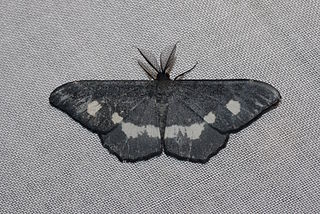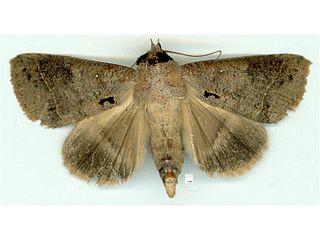Mosopia is a genus of moths of the family Erebidae. It is found in south-east Asia, including Thailand, Borneo and Malaysia. The genus was first described by Francis Walker in 1866 from a specimen in the British Museum. The specimen Walker describes was from Penang in Malaysia.

Hyposidra is a genus of moths in the family Geometridae first described by Achille Guenée in 1857.

Comostola pyrrhogona is a moth of the family Geometridae described by Francis Walker in 1866. It is found in the Indo-Australian tropics from India, Sri Lanka to Taiwan, and east to Vanuatu, New Caledonia, northern Australia and Norfolk Island.

Tiracola plagiata, the cacao armyworm, is a species of moth in the family Noctuidae. The species was first described by Francis Walker in 1857. It is found from south-east Asia, southern India, Sri Lanka, Myanmar to the South Pacific Islands, including the northern two-thirds of Australia.

Mnesiloba dentifascia is a moth of the family Geometridae first described by George Hampson in 1891. It is known from the Oriental tropics.

Scirpophaga incertulas, the yellow stem borer or rice yellow stem borer, is a species of moth of the family Crambidae. It was described by Francis Walker in 1863. It is found in Afghanistan, Nepal, north-eastern India, Sri Lanka, Bangladesh, Myanmar, Vietnam, Thailand, Malaysia, Singapore, Sumatra, Java, Borneo, Sumba, Sulawesi, the Philippines, Taiwan, China and Japan.

Arctornis submarginata is a species of moth of the subfamily Lymantriinae of family Erebidae. It is found in the north-eastern Himalaya and Sikkim, Sri Lanka, on Borneo and Sumatra and in northern Australia.
Scopula adeptaria is a moth of the family Geometridae. It was described by Francis Walker in 1861. It is found in Sri Lanka, India, Taiwan, Hainan, southern Myanmar, Peninsular Malaysia, Borneo, the Philippines, Sumba and northern Australia.

Thumatha fuscescens is a moth of the family Erebidae first described by Francis Walker in 1866. It is found in Australia, South-East Asia, India, Sri Lanka, the Comoros, Réunion, Madagascar, and Gabon.
Eriopithex recensitaria is a moth in the family Geometridae first described by Francis Walker in 1862. It is found in Sri Lanka, Taiwan, on Borneo and in the Australian state of Queensland.
Glaucoclystis polyclealis is a moth in the family Geometridae described by Francis Walker in 1859. It is found in Sri Lanka and on Borneo, Java and Bali.
Mnesiloba cauditornata is a moth in the family Geometridae. It is found in New Guinea.
Carbia pulchrilinea is a moth in the family Geometridae. The species was first described by Francis Walker in 1866. It is found in the Indian subregion, Sri Lanka and New Guinea, as well as on Borneo, the Mentawai Islands and the Bismarck Archipelago. The species is found from lowlands to the upper montane forest zone.

Polynesia sunandava is a moth in the family Geometridae. It is found in Sri Lanka and India, as well as on Peninsular Malaysia, Sumbawa, Larat and in New Guinea.
Sauris hirudinata is a moth of the family Geometridae. It was described by Achille Guenée in 1858. It is found in Fiji, Sri Lanka, India, Hong Kong, as well as on Peninsular Malaysia and Borneo.

Pantydia metaspila is a species of moth of the family Erebidae first described by Francis Walker in 1858. It is found in China, Japan (Ryukyus), India (Maharashtra), Thailand, Taiwan, the Maledives, Sri Lanka, the Philippines, Borneo, Sumatra, Sulawesi, the Tanimbar Islands, Seram, Papua New Guinea, the Caroline Islands, the Solomon Islands, Vanuatu, Fiji, as well as Australia, where it has been recorded from Queensland.

Hyposidra talaca, the black looper or black inch worm, is a moth of the family Geometridae. The species was first described by Francis Walker in 1860. It is found from India to Indochina, Sundaland, Sulawesi, the Philippines, Sri Lanka, the Solomon Islands, Thailand, Taiwan, New Guinea and Australia, where it has been recorded from Queensland. It is a major defoliating pest in tea plantations.
Phalacra vidhisara is a moth in the family Drepanidae. It was described by Francis Walker in 1860. It is found in Sri Lanka and India.
Giaura tortricoides is a moth of the family Nolidae first described by Francis Walker in 1865. It is found in Sri Lanka, Japan, Andaman Islands, Borneo, Sumatra, Flores, Sulawesi, New Guinea, Bismarck Islands and Australia.
Beara dichromella is a moth of the family Nolidae first described by Francis Walker in 1866. It is found in Sri Lanka, and India.









